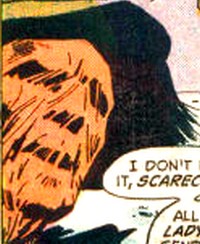 |
|
WHAT DO
MEN FEAR MOST?
THINGS THEY DO NOT UNDERSTAND ---
CUNNING TRICKS THAT SEEMINGLY DO NOT
"MAKE SENSE"
AND SO CANNOT BE WARDED OFF BY ORDINARY
INTELLIGENCE! AND IN ALL THE WORLD
NONE KNOWS THIS BETTER THAN THE
SCARECROW,
RENEGADE COLLEGE PROFESSOR AND AUTHORITY
ON THE PSYCHOLOGY OF
TERROR!
(from
the splash page of Detective Comics #73,
March 1943)
|
|
|
| |
Although
an early Golden Age introduction to the ranks of
Batman villains, Dr Jonathan Crane aka "The
Scarecrow" spent the first 30 years of his
existence as a highly marginal character with as few
as only five appearances between 1942 and 1972. His
characterization throughout this period only
scratched the surface of what the Scarecrow is known
to be today, and even appeared contradictory to some
extent. It was only midway through the Bronze Age
that the Scarecrow was truly defined and turned into
one of the most dangerous and, in spite of his
appearance, possibly most plausible and credible
villains the Batman could possibly face.
ORIGIN
STORY
In World's
Finest Comics #3 (Fall 1941) Bill Finger and Bob
Kane introduced readers to Dr Jonathan Crane who, in a story
entitled "Riddle of the Human Scarecrow", is no
longer able to ignore the fact of just how much his
colleagues amongst university staff are laughing about
his shabby clothes behind his back and even likening his
appareance to that of a scarecrow. Finally, Crane decides
to have no more of this mockery and show them all by
applying his expertise in the psychology of fear for
criminal means.
|
| |
| Taking
up the remarks made by his colleagues and
given the fact that as a small boy Crane
liked to frighten birds, he decides to
make the scarecrow his symbol. Dressed up
accordingly - wearing a ragged black hat,
a trench coat, a mask, and wielding a
Tommy gun - Crane decides to turn the
subject of one of his former lectures
into reality by setting up a protection
racket and extortion scheme, applying his
expertise to exploit the fears and
phobias of his victims for his personal
financial profit as well as his personal
satisfaction. Now, at long last, people
will tremble before him rather than
mocking him.
When a
businessman who has sued his former
partner refuses to cooperate with the
Scarecrow and meet his demands (i.e. drop
the case against his partner, who is
paying the Scarecrow to that effect), he
is killed by the nightmarish villain, who
instantly becomes a media sensation.
Bruce Wayne,
who is both a patron and a trustee of the
university, investigates the matter as
Batman and discovers Crane's disturbing
topic of research and that he was forced
to resign due to his dangerous
experiments in class.
Batman
suspects Crane to be the Scarecrow, who
repeats his hired gun protection racket
scheme, this time with a store owner, by
offering to rob other establishments in
order to increase his sales. When Batman
and Robin learn of the plan and question
the store owner, the Scarecrow attempts
to kill him but the Dynamic Duo capture
him just in time, and Crane is sent to
Gotham State Penitentiary.
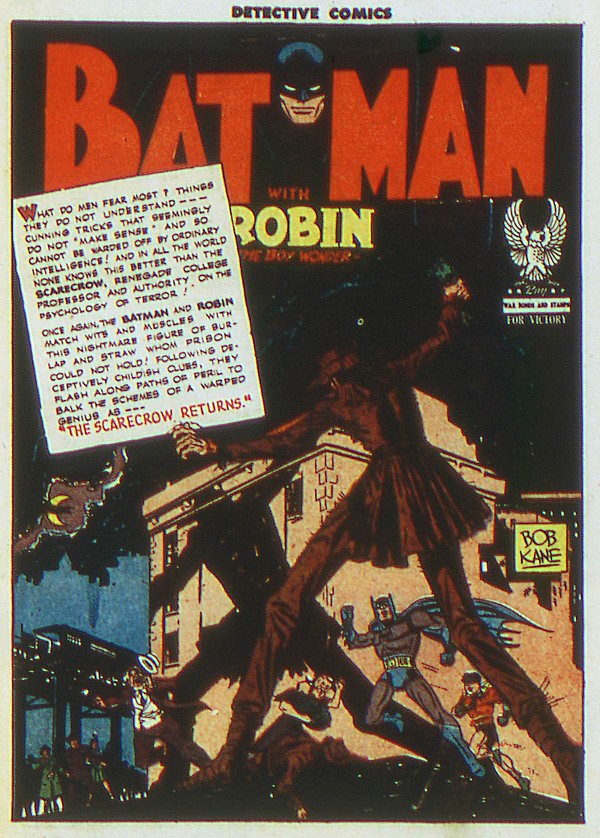
Detective Comics #73
(March 1943) - the Dynamic Duo again
"MATCH WITS WITH
THIS NIGHTMARE FIGURE OF BURLAP AND STRAW
WHOM PRISON COULD NOT HOLD!"
|
|
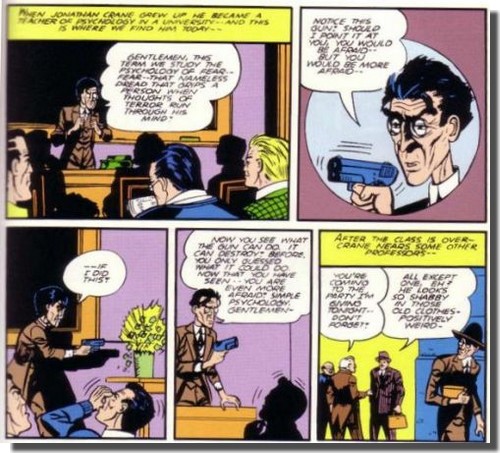
World's Finest
Comics #3 (Fall 1941)
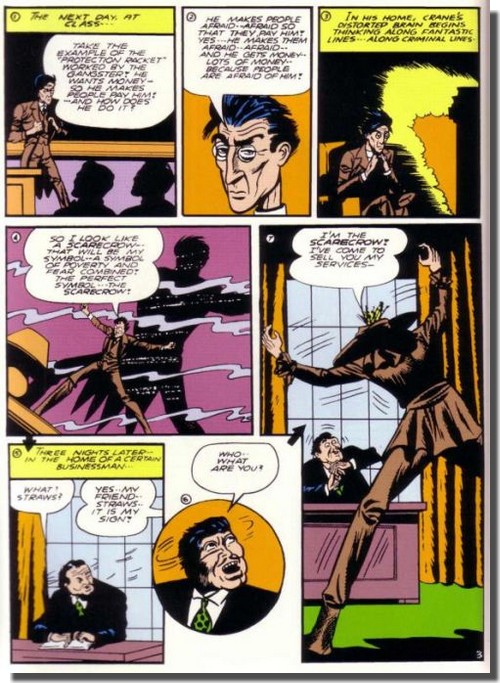
World's Finest Comics #3 (Fall 1941)
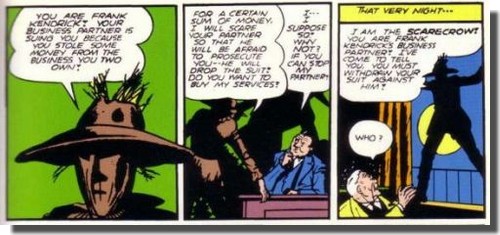
World's Finest Comics #3 (Fall 1941)
|
|
|
| |
EVOLUTION
OF THE CHARACTER & APPEARANCES
Having escaped
from prison, the Scarecrow is aided in Detective Comics #73
(March 1943) by a gang
of henchmen and begins a new campaign of crime by
launching a series of spectacular crimes, all centering
around three letter words. At the scene of each crime
Crane leaves a clue in the form of words which rhyme with
hat. Batman and Robin decipher the clues and turn up to
stop the crook, but only narrowly escape a death trap set
for them before finally trailing the Scarecrow to the
scene of another robbery where they apprehend and stop
the "Man of Straw".
As can easily be deduced
from the short synopsis of Detective Comics #73,
writer Don Cameron portrayed a markedly less sinister
villain than Finger in his original introduction of the
character. Whereas Finger's Dr Crane draws from his
experience and knowledge of the psychology of fear and
ultimately suggests that he acts like a mad scientist but
actually might just be sane enough to pose an even
greater threat to society, Cameron's characterization of
the Scarecrow as a gimmick villain tones down Crane from
University level to an elementary school teacher as he
leaves three letter words on blackboards for the Dynamic
Duo to decipher in what looks and feels much more like a
classroom "now who's got the right answer"
setting than a scientific experiment in fear and terror.
|
| |
| Although
still framed by Crane's reflections on the
applied psychology of fear to some extent, the
Scarecrow's threat potential is greatly reduced
by this simplistic three letter words gimmicky
characterization. Perhaps not surprisingly, the
Scarecrow vanished from the ranks of Batman foes
following his appearance in Detective
Comics #73,
and he remained in limbo for no less than twenty
four years until DC Golden Age veterans Gardner
Fox and Sheldon Moldoff reintroduced the
"Master of Fear" in Batman
#189 (February 1967). Since his last foray into
the world of the Darknight Detective had taken
place so long ago in real time, Fox decided to
make sure he would be on the safe side, and began
his story by giving a detailed account of the
Scarecrow's origin from World's Finest Comics
#3.
The 1960s Batman TV
show was at the peak of its popularity at the
time Batman #189 was published, and the
campiness it instilled into Batman comics is very
much in evidence as Fox portrays the Scarecrow -
almost in contradiction to Carmine Infantino's
eerie and menacing cover artwork - as a villain
who perhaps is more gimmicked than ever as he
actually leaves clues in the form of pieces of
straw, spelling out words such as Park, Ark,
and Mark which the Dynamic Duo plus
Bat-Computer need to decipher in order to catch
the Scarecrow in flagranti.
|
|
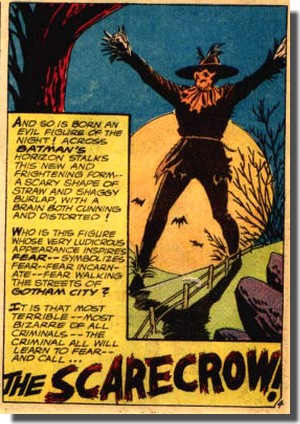
Batman #189
(February 1967)
|
|
| |
There is, however, one
important element which would become a central prop to
the characterization the Scarecrow would ultimately
receive, and once again, Gardner Fox proved his quality
(just as he did in some of the earliest Batman stories of
1939) not so much as a storyteller but as an innovator - just as he had
supplied the Batman with his utility belt, Batrope,
Batarang and Batgyro, he provided the Scarecrow with his
ultimate weapon: a
gaseous state of matter compound with the quality of
inducing fear - or, put more poignantly: fear gas!
"Gardner
Fox was (...) not the greatest writer, but very
capable and reliable, a good plot man." (Schwartz, 2000)
|
| |
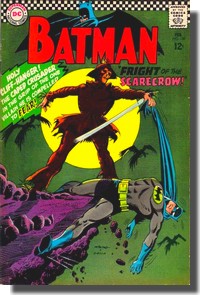
Batman #189
(February 1967)
|
|
Although
simply described as "a chemical spray"
and featured in one single panel of Batman
#189 only (emitted, by the way and for
clarification of the artwork, through a
periscope-like fixture on top of a submarine
floating in the lake of Gotham Park...), and it
resurfaces later on in the story for yet another
single panel, although this time depicted as a
whiff of smoke coming from a pipe which the
Scarecrow seems to be smoking. Fox thus created the nucleus
for what would eventually become the Scarecrow's
principal modus operandi for creating a
rush of fear in his victims as Dr Jonathan Crane
no longer solely relied on psychology (and his
appareance) as such.
|
|
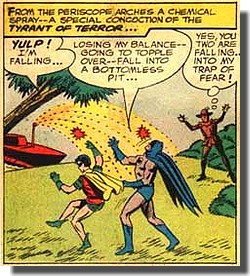
Batman #189
(February 1967)
|
|
| |
| Of course the idea of
having a villain use some kind of fear gas was far from
being original or new - Bill Finger had provided
Professor Hugo Strange with "fear dust" in Detective
Comics #46 (December 1940), and Stan Lee had
supplied Marvel's Mister Fear with "fear gas"
in Daredevil #6 (February 1965) - but Fox was
the first writer to associate the Scarecrow with what has
since become his foremost and best known weapon. Scarecrow next had the honour of
being the villain featured in the anniversary 200th issue
of Batman (March, 1968), where writer Mike
Friedrich and artists Chic Stone and Joe Giella had the
Scarecrow perfect a fear-radiated pill which makes Batman
and Robin fear Crane when they swallow it. Once again,
however, the gimmicky aspect of the Scarecrow prevails
and dominates as he leaves a trail of clues for the
Dynamic Duo to follow. This time, Batman and Robin
capture Joker, Killer Moth and Penguin only to discover
clues on each captured crook which lead them to the
Scarecrow.
|
| |
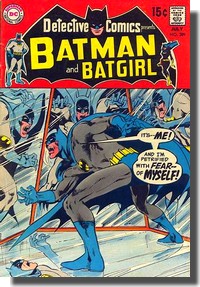
Detective Comics #389
(June 1974)
|
|
The Scarecrow next
appeared in Detective Comics
#389 (June 1974) in a story entitled
"Batman's Evil Eye!", where
writer Frank Robbins and artist Bob Brown
tell the story of how the Scarecrow is -
once again - released from prison only to
spring a fear-trap on Batman, who
initially seems to have regained his
ability to strike terror into the hearts
of criminals through his mere presence -
and Batman realizes that he needs to
confront the Scarecrow once again.
Possibly best known for its gorgeous Neal
Adams cover depicting a Batman who is
scared of himself in a mirror maze, the
story itself had far less thrills to
offer, even though it moved the Scarecrow
somewhat away from the simplistic
gimmicked villain he had previously been.
In addition, the
Scarecrow enjoyed an appearance that same
month in Justice League of America
#111 (May/June 1974) as a member of the
Injustice Gang.
|
|
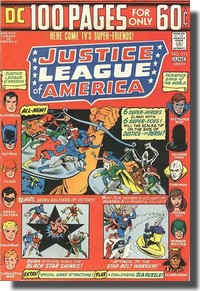
Justice League of
America #111
(April 1975)
|
|
|
| |
| It wasn't
until April 1975 and Batman #262, however, that
writer Denny O'Neil, artist Ernie Chan (credited as Chua)
and inker Dick Giordano gave readers the first
incarnation of what would eventually make the Scarecrow
one of the most popular recuring Batman villains. |
| |
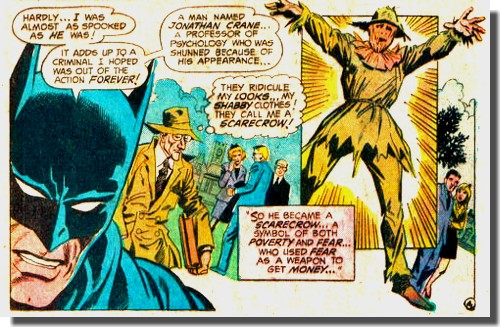 |
|
In "The Scarecrow's
Trail Of Fear!" O'Neil follows the path set
out by Fox by recapping the origin of the
Scarecrow, but then quickly leaves the beaten
path and depicts Crane as the socially deranged
yet scientifically brilliant - and hence ultra
dangerous - man as which he is seen in the Batman
universe today. O'Neil also confirms Crane's
use of technological aids (in this case radio
waves which send out vibrations to the
parasympathetic nervous system) in order to cause
and induce a state of excessive fear in his
victims.
O'Neil and Chan recap the
story of why and how Stephen Crane became the
Scarecrow nicely in Batman #262
|
|
| |
| From here
on, O'Neil takes the reader on a thrilling and action
packed adventure, with well-paced and fast moving
plotting and storytelling which is complemented by
excellent artwork from Chan. Depicted in such a way, the
Scarecrow made an impact and was back again fairly soon -
if somewhat surprisingly - in Joker #8
(July/August 1976), the Prince of Crime's short-lived
solo series. |
| |
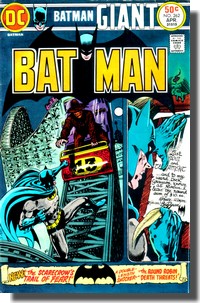
Batman #262
(April 1975)
|
|
Scripted by
Elliot S. Maggin and pencilled by
Irv Novick, the twist of the
story was contained in the fact
that this time it was actually
the Joker impersonating the
Scarecrow in a number of criminal
escapades until being confronted
by Crane. The encounter
offered interesting possibilities
as both the Joker and the
Scarecrow share similarities in
the setup of their psychotic
personalities, but Maggin opted
for the lighter side of the two
characters rather than shining a
light into those dark corners of
their souls.
The Scarecrow
then appeared in June 1977 in Justice
League of America #143,
again as member of the Injustice
Gang, before featuring in the
multi-issue story arc "Where
were you on the Night Batman was
killed?" in Batman
#291-294 (September through to
December 1977).
|
|
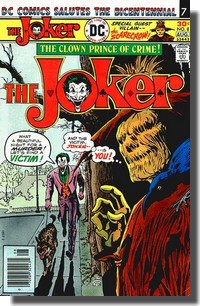
Joker #8
(April 1975)
|
| |
|
|
|
|
|
|
|
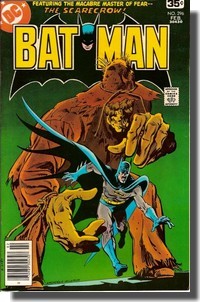
Batman
#296
(February 1978)
|
|
Back
again in February 1978
for Batman #296,
the Scarecrow develops a
chemical that produces
phobophobia, i.e. the
fear of one's own fears.
Crane plans to use this
agent with individuals
suspected of unsolved
crimes, forcing them to
want to return their loot
at a specific place and
time set up the Scarecrow
- who then picks up the
goods for himself. As
Batman discovers Crane's
latest scheme he
confronts the "Man
of Straw" and, for
the first time, proves
himself able to resist
the Scarecrow's fear
chemical and send Crane
back to prison. David
Vern (credited as David
V. Reed) provided the
script, with artwork from
Sal Amendola (who also
drew the dynamic cover).
The
Scarecrow's next
appearance was again as a
member of the Injustice
Gang in Justice
League of America
#158 (September 1978),
followed by Detective
Comics #486
(October/November 1979)
in which Robin got to
fight the Scarecrow in a
story by Jack C. Harris
illustrated by Kurt
Schaffenberger and Jack
Abel.
The
Scarecrow was then seen
again in May 1980 in Super
Friends #32 before
appearing in Untold
Legend of the Batman
#2 (August 1980).
|
|
|
|
|
| |
| O'Neil's
basic concept of portraying and understanding the
Scarecrow to be a highly ambiguous and therefore
extremely dangerous sociopath was revisited by Gerry
Conway in "The 6 Days Of The Scarecrow" from Detective
Comics #503 (June 1981), and he put the finishing
touches to the raw diamond presented by O'Neil. |
| |
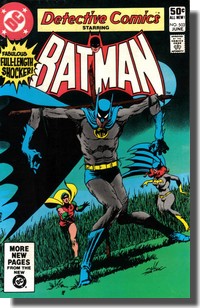
Detective Comics #503
(June 1981)
|
|
Pencilled by Don
Newton and inked by veteran Marvel
bullpenner Dan Adkins, this portrayal is
the first to fully dive into the
disturbingly twisted yet brilliant mind
of Stephen Crane as he literally infects
the Batman with a toxin that causes
extreme fear reactions in all individuals
which Batman or Bruce Wayne meet. The
Scarecrow's main criminal activity is
revealed to lie in the manufacture and
distribution of illegal drugs through a
chemical corporation which Crane has
aquired. The Scarecrow made an
appearance in DC Special Series
#27 (Fall 1981) and was next seen in Brave
and the Bold #197 (April 1983), when
writer Alan Brennert and artists Joe
Staton and George Freeman showed Batman
being unable to summon his usual allies
such as Robin, Batwoman or Alfred and
hence turning to an old enemy (and love
interest) - i.e. Catwoman - for help.
|
|
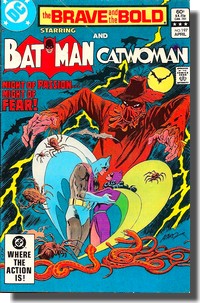
Brave and the
Bold #197
(April 1983)
|
|
|
| |
| Just how
much the Scarecrow had by now taken center stage in the
Batman universe can be seen from the fact that Crane and
the "Man of Straw" appeared in Detective
Comics #526 (May 1983), which celebrated the 500th
appearance of Batman in that title. Now an
established mainstay villain, DC's "Master of
Fear" clocked up no less than ten appearances
between 1984 and 1986: Batman #368 (February
1984), Batman #373 (July 1984), Detective
Comics #540 (July 1984), Batman #380
(February 1985), Red Tornado #1 (July 1985), World's
Finest Comics #321 (November 1985), Crisis on
Infinte Earths #9 (December 1985), Who's Who:
The Definitive Directory of the DC Universe #11
(January 1986), Batman #400 (October 1986), and Who's
Who: The Definitive Directory of the DC Universe #20
(October 1986). |
| |
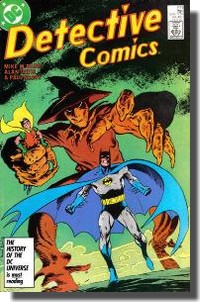
Detective
Comics #571
(March 1987)
|
|
The Scarecrow
was back again in Detective
Comics #571 (March 1987) in
the by now classic tale
"Fear For Sale" by Mike
W. Barr, illustrated by Alan
Davis and Paul Neary who depicted
an extremely loose limbed Crane
going back to his criminal roots
as an extortionist and murderer.
Barr reverts the Scarecrow's
usual modus operandi by having
Crane actually remove
all instincts of fear in a number
of athletes who engage in
dangerous sports - causing them
to take enormous risks. As
Batman, who is investigating
various mysterious sport
accidents, is infected himself
the Darknight Detective needs to
make sure that he does not
actually kill himself in a
reckless move to save Jason Todd
in one of his earlier outings as
Robin. Further
appearances of the Scarecrow in
the 1980s took place in Batman
#415 (January 1988), Secret
Origins #23 (February 1988),
Arkham Asylum (1989,
Original Graphic Novel), Detective
Comics #600 (May 1989), Sandman
#5 (May 1989), Sandman
#7 (July 1989), Captain Atom
#33 (September 1989), Detective
Comics #606 (October 1989)
and Detective Comics
Annual #2 (1989).
|
|
|
|
| |
| As of the
1990s, the Scarecrow has appeared so often that a
complete listing of all his appearances throughout
publications of the DC Universe would defeat the scope of
this portrayal. Alongside being featured in a large
variety of different DC titles he appeared in numerous
issues of the two core Batman Universe titles: |
| |
| Batman #456
(November 1990), Batman #457
(December 1990), Batman Annual
#15 (1991), Batman #491 (April
1993), Batman #494 (June 1993), Batman
#495 (June 1993), Detective Comics
#661 (June 1993), Batman #496
(July 1993), Batman #497 (July
1993), Detective Comics #664
(July 1993), Batman #0 (October
1994), Detective Comics #0
(October 1994), Batman #523
(October 1995), Batman #523
(November 1995), Batman Annual
#19 (1995), Batman #561 (January
1999), Batman #562 (February
1999), Batman #564 (April 1999),
Detective Comics #731 (April
1999), Batman #584 (December
2000), Detective Comics #778
(March 2003), Detective Comics
#779 (April 2003), Detective Comics
#780 (May 2003), Detective Comics
#781 (June 2003), Detective Comics
#782 (July 2003), Batman #617
(September 2003), Batman #626
(June 2004), Batman #627 (July
2004), Batman #628 (July 2004), Batman
#629 (August 2004), Batman #630
(September 2004), Batman #633
(December 2004), Detective Comics
#799 (December 2004), Detective
Comics #820 (August 2006), Detective
Comics #835 (October 2007), Detective
Comics #836 (November 2007), Detective
Comics #847 (October 2008), Detective
Comics #848 (November 2008), Detective
Comics #849 (December 2008), Batman
#683 (January 2009), Detective
Comics #851 (February 2009), Batman
#686 (April 2009) and Detective
Comics Annual #11 (2009). |
|
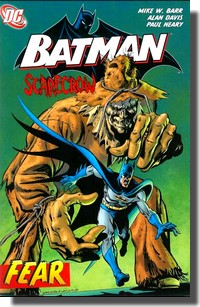
Batman: Fear
(January 2006)
|
|
|
| |
| In 2005, DC issued a
collected edition Batman: Scarecrow Tales which
reprinted eight stories spanning more than 60 years from World's
Finest #3 (1941) to Batman: Gotham Knights
#23 (2002), and in 2006 this was followed by a 28-pages
reprint of "Fear for $ale" from Detective
Comics #571 as Batman:
Fear, which borrowed its cover from Batman #296
(February 1978) and also reprinted a character file page
on the Scraecrow from Batman Villains Secret Files #1
(October 1998). The Scarecrow has swiftly
made it into the "New 52" DC Universe and
featured in a number of issues of Batman Dark Knight
since the relaunch of all of DC's titles in September
2011.
Finally, the
Scarecrow was also featured in the Marvel/DC company
crossover Batman/Daredevil: King of New York
(2000) where he attempts to use the Kingpin's crime
empire to disperse his fear gas all over Gotham but is
defeated by Daredevil who lives up to his 'Man Without
Fear' title by proving immune to the gas.
|
| |
MODUS
OPERANDI
Scarecrow's
chief weapon is a toxin he himself created and which is
commonly depicted as being a fear gas which causes his
victims to visualize their worst fears as though they
were real. With his profound knowledge in the field of
psychology, Crane can also cause an individual to develop
a fear of something they never had before. The volatile
form of his toxin allows the Scarecrow to store and use
it in all kinds of containers, such as pellets, darts,
capsules, etc.
Crane's
outfit is a direct result of his colleagues likening him
to a scarecrow, but it naturally also serves to enhance
the scary effects of the hallucinogen whilst acting as a
gas mask, even though he himself has become immune to it
over time - something the Batman tries to achieve too by
subjecting himself to small doses of Crane's toxin over
time (though invariably the Scarecrow will return with an
"improved" version of his fear gas the next
time the two adversaries meet).
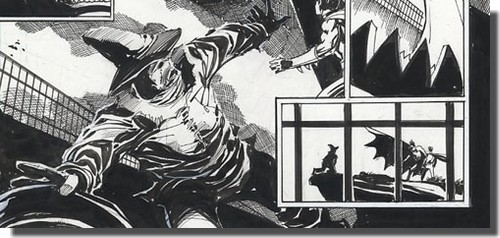
An
iconic hero and his iconic villain The Scarecrow - from Detective
Comics #836
(pencils
and inks by Tom Mandrake, scanned from the original
artwork page [personal collection])
Although
generally avoiding direct contact with his victims, the
Scarecrow is fairly skilled in hand-to-hand combat and
has developed his own style of martial arts which Crane
calls "violent dancing" and which relies
heavily on the range of his long arms and legs. If
turning to weapons, the Scarecrow tends to stick to his
character and uses agricultural tools such as pitchforks,
sickles and scythes.
|
| |
SCARECROW
IN OTHER MEDIA
The
Scarecrow appeared in the 1968 Filmation
TV cartoon series Batman with Robin
the Boy Wonder (actually half of The
Batman/Superman Hour) in an episode
entitled "The Great Scarecrow
Scare". Voiced by Ted Knight, the
character was toned down for its
primarily pre-teen audience by having him
use simple knockout gas instead of fear
gas and using eggs as containers.
In Batman:
The Animated Series the Scarecrow was
voiced by Henry Polic II and appeared in
the episode "Nothing to Fear"
(actually the third episode of the first
season, it was the tenth episode to air
due to schedule changes). Here Crane is
plotting to use his fear gas to take
revenge on the Gotham University Board
Members that fired him for his fear
experiments. In bringing Scarecrow to
justice, Batman is shown to actually use
Crane's own toxin against him after
Scarecrow retreats to his own chemical
plant.
In the later
New Batman Adventures the
Scarecrow had several episode appearances
and could also be seen in episodes of
various other cartoon superhero TV shows.
On the
silver screen, the Scarecrow was planned
to star as the main antagonist in Batman
Triumphant, the fifth film in the
1990s movie franchise, with Nicolas Cage
and Steve Buscemi rumoured as having been
the most likely candidates for the role.
However, following the negative impact of
Batman & Robin (1997) the
franchise was put on hiatus until Batman
Begins (2005), which did feature The
Scarecrow (played by Cillian Murphy) as
one of the main villains.
Murphy was
back for his role in The Dark Knight
(2008) and The Dark Knight Rises
(2012), where Crane is still shown as
wearing only a simple mask instead of the
full Scarecrow costume. He is the only
villain to appear in all three parts of
the Nolan Batman trilogy.
|
|
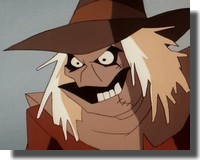
The Scarecrow in Batman
The Animated Series and Batman
The Dark Knight
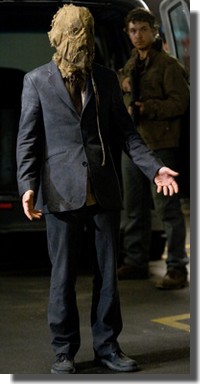
|
|
|
| |
THE
"OTHER" SCARECROWS
None of the
individuals involved in the creation of the Scarecrow
seems to ever have talked about the circumstances
involved, but given the character's very limited profile
and success for the first 30+ years of his existence,
this may hardly be called a surprise as neither Bill
Finger nor Bob Kane had any specific reason to remember
anything in conjunction with the Scarecrow.
|
| |
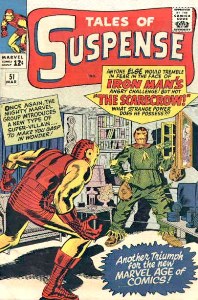
Tales of
Suspense #51
(March 1964)
|
|
Competitor
Marvel Comics also has its
Scarecrow character (even if DC
had had any interest in doing so,
it would have been almost
impossible to trademark the name
and character) - in fact the
House of Ideas even has two of
them. The first
Scarecrow was a one-off Iron Man
villain introduced in Tales of
Suspense #51 (March 1964),
whereas the better known Marvel
Scarecrow is a
mysterious character who has the
ability to leave a painting and
spread terror. Appearing for the
first time in Dead of Night #11
(August 1975) - one of Marvel's
many horror anthology titles from
the 1970s - Scott Edelmann (plot)
and Rico Rival (pencils)
conceived their Scarecrow to be a
Dorian Gray like figure. Albeit
an interesting concept it wa
short lived, and in spite of
plans for its own series, the
appearances of the Scarecrow
thereafter were limited to
one-off stints in Marvel
Spotlight #26 (February
1976) and Marvel Two-In-One #18
(August 1976).
|
|
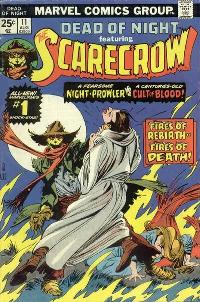
Dead
of Night #11
(August 1975)
|
|
|
|
| |
| In 2009, DC's Scarecrow was
ranked as the 58th greatest comic book villain of all
time by IGN, who felt that "few villains have
done more with less." [1] * *
* * *
NOTES
[1]
comics.ign.com/top-100-villains/58.html, accessed 13 June
2012
|
| |
|
| |
| BIBLIOGRAPHY SCHWARTZ Julius & Brian M.
Thomsen (2000) Man of Two Worlds, Harper
|
| |
|
| |
| |
BATMAN and all
related elements are the property of DC
Comics, Inc. TM and © DC Comics, Inc.,
a subsidiary of Time Warner Inc.
The
illustrations presented here are copyright
material. Their reproduction for the review
and research purposes of this website is
considered fair use as set out by the
Copyright Act of 1976, 17
U.S.C. par. 107. This is a
non-commercial and non-profit website and not
associated or affiliated with DC Comics
Text is
copyright 2012-2014 Adrian Wymann
originally posted 20 June 2012
reposted 20 April 2014
|
| |
 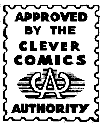
|
|
